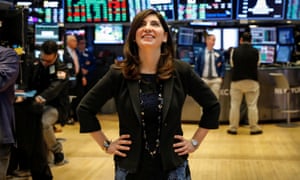
Stacey Cunningham, who began her career as a summer intern on the New York stock exchange 24 years ago, will become the first woman to head the 226-year-old financial market on Friday, an appointment that raises hopes that the glass ceiling may have finally cracked on Wall Street.
But has it? Cunningham takes up the position as the financial services sector is struggling to show it has moved beyond the cliches of Wall Street’s sexist culture.
Little epitomized Wall Street better than the pre-digitized NYSE – at the time the now 43-year-old Cunningham joined she was one of just three dozen women among more than 1,000 men.
When she first arrived, Cunningham recalled last year, the women’s restroom on the seventh floor was inside an old phone booth. Men, she said, had a “palatial” bathroom next door with couches and a full-time attendant.
But while Cunningham has her work cut continuing to modernize NYSE’s trading operations and induce more companies to list publicly, Wall Street itself is eager to show it is on the path to gender parity.
In a symbolic gesture, city authorities led by New York’s mayor, Bill de Blasio, moved the Fearless Girl, a statue commissioned to stare down the 7,000lb Charging Bull of Wall Street, to a spot outside the exchange.
In interviews, Cunningham has acknowledged the women who came before her, among them Muriel Siebert, a Wall Street legend as the first woman to join the exchange as a trader in 1967.
“I was a woman trader on the floor, and I never thought about it – I never thought for a moment whether or not that could happen, and whether or not that was an opportunity available to me,” Cunningham told the Street in March.
“And it’s because Muriel paved the way. I think it’s just really important to recognize that any time a woman pushes the boundaries and redefines the boundaries, she’s redefining them for everyone else that follows her.”
But to some ways of thinking, celebrating Cunningham is itself a testament to how few women achieve top leadership positions on Wall Street.
Two weeks ago, the Campbell Soup CEO, Denise Morrison, abruptly stepped down, triggering hand-wringing that her departure left just 23 women as CEOs of Fortune 500 companies, a drop from 32 in 2016.
Morrison followed a number of other high-profile women out of the door, including Meg Whitman at Hewlett-Packard, Irene Rosenfeld of Mondēlez, Sheri McCoy of Avon and Margo Georgiadis at Mattel.
On the plus side, there is still Mary Barra at General Motors, Marillyn Hewson at Lockheed Martin, Ginni Rometty at IBM and Indra Nooyi at Pepsi.
But according to Kathryn Kolbert, founder and outgoing director of the Athena Center for Leadership Studies at Barnard College, the fact that we still count arrivals and departures of female executives is testament to how much remains to be done.
“If you look at the pace of change it’ll take another 100 years to get to parity.”
According to figures Kolbert compiled two years ago, women hold just 16% of board seats and 14% of executive officer positions on the Fortune 500 list. A quarter of those firms had no women at all in executive leadership positions.
The figures are improved for the financial industry, which boasts 29% women in senior leadership positions but precious few at the top level.
“You cannot have gender parity until you have critical mass, and you do not have critical mass until you get to 30%,” says Nathalie Molina Niño, CEO of Brava Investments and the author of Leapfrog: The New Revolution for Women Entrepreneurs. “It’s only then that you really start to see culture change. Having one woman on a board really makes no difference at all.”“Yet we know that having women at high levels of leadership not only improves the bottom line but makes a company much more creative, innovative and responsive to its clients, yet I don’t see a significant change in the numbers of women at high levels of leadership at financial services companies,” Kolbert said.
In Kolbert’s view, improving gender equality is a question of will.
“It’s not hard to do. We know that when a senior member of a Fortune company wants change, it happens and it happens quickly. I have long believed companies not only need to see the advantage, but need the will to make the change.”
That corresponds with the thinking of Elissa Ellis Sangster, executive director of the Forté Foundation, a group that helps guide women in business. Sangster told the Guardian she too found it “frustrating” that we’re still celebrating when women are named to top positions.
“You’d think by now the pipeline would be 50-50 and we’d see enough women in one-level-down positions who are ready and able to helm some of these top companies.”
Since you’re here …
… we have a small favour to ask. More people are reading the Guardian than ever but advertising revenues across the media are falling fast. And unlike many news organisations, we haven’t put up a paywall – we want to keep our journalism as open as we can. So you can see why we need to ask for your help. The Guardian’s independent, investigative journalism takes a lot of time, money and hard work to produce. But we do it because we believe our perspective matters – because it might well be your perspective, too.
I appreciate there not being a paywall: it is more democratic for the media to be available for all and not a commodity to be purchased by a few. I’m happy to make a contribution so others with less means still have access to information.Thomasine, Sweden

No comments:
Post a Comment